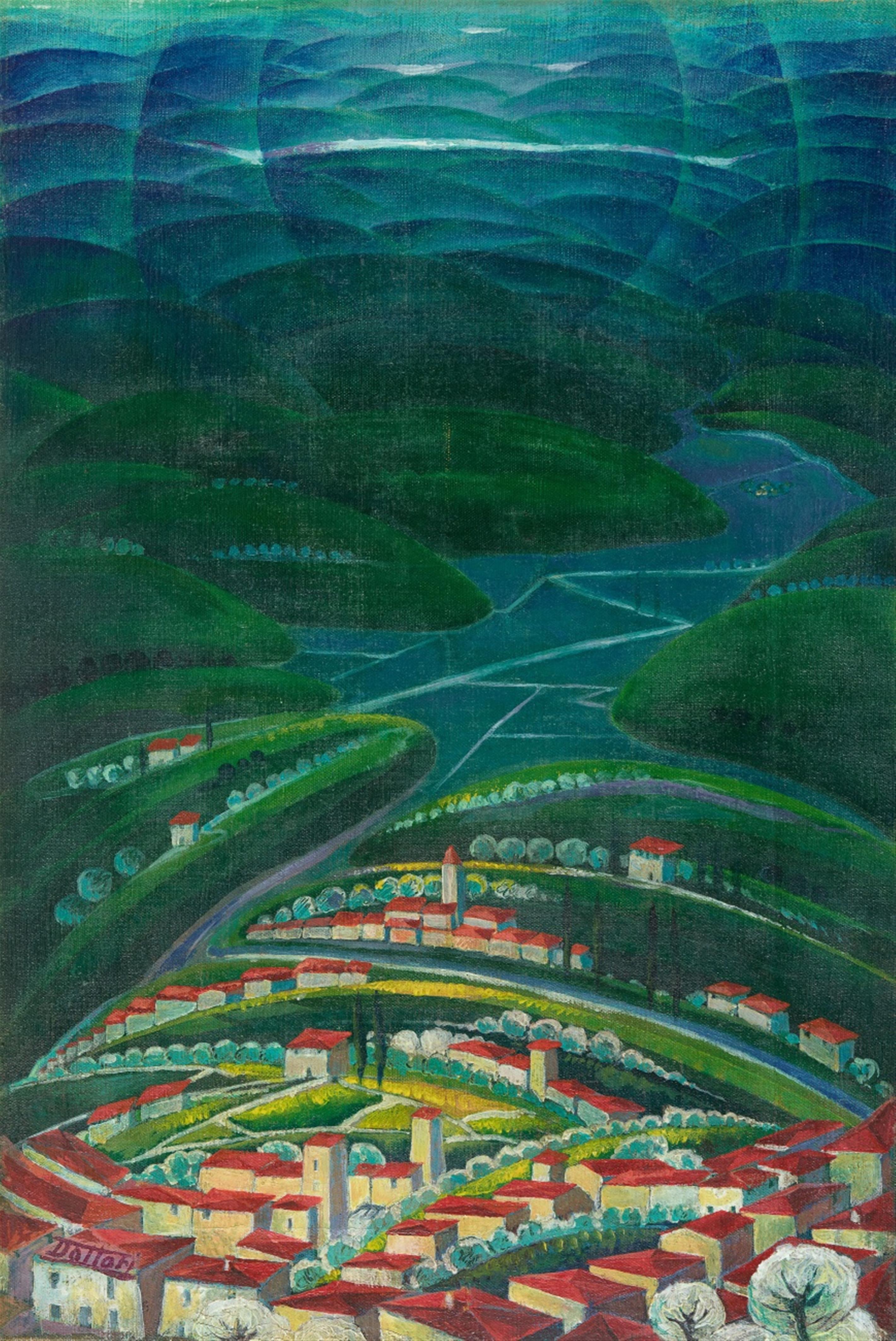Gerardo Dottori
Paesaggio collinare
Circa 1920-1930
Oil on canvas 63.5 x 43.5 cm Framed under glass. Signed 'Dottori' in red lower left. - Verso label and stamp of Galleria Artecentro, Milan, thereon with archive no. 9182. - Short retouched tear in upper part of picture, backed by canvas patch (old).
With the motif captured in a narrow vertical format and seen from a great height, the viewer's gaze is directed towards a hilly landscape and a small town. The connection between the country and town is formed by a body of water - a river or lake - that divides the picture plane up in zigzag forms and gives it rhythm. The structures of the town have been abstracted into an arc and are repeated in the low, semicircular forms of the hills and the structures of the sky in the manner of concentric circles. Everything bends into a curve before viewers' eyes, as though their great distance were already sufficient to make the curvature of the earth perceptible and as though the horizon pointed all the way into the universe.
In his early works, Gerardo Dottori anticipated Aeropittura, a phase in Italian Futurism that grew out of this movement's interest in and enthusiasm for machines, while enriching it through flight, aeroplanes and extraterrestrial themes. As described by Enrico Crispolti, Aeropittura also served as a visual metaphor for the mind's transcendence to a higher level of consciousness. Crispolti writes that Dottori combined the idiom of the avant-garde and the realists with his extreme bird's-eye views down on to a vibrant scenography of stylised geometric and crystalline forms (see Crispolti 1989, op. cit., pp. 168 f.). Futurism encompassed visual art - painting and sculpture - as well as literature and music. Gerardo Dottori completed his studies at the art academy in Perugia, worked as a decorator and was also active as a writer - this same Dottori, who initially painted symbolist motifs in a divisionist manner, would meet Giacomo Balla in 1911/1912 and join the Futurist movement. Dottori took part in World War I, though without the enthusiasm of the Futurists, and continued to work on his art during this period. Participating in various group exhibitions and the founding of the journal “Griffa!”, his work first resonated with critics in 1920. In 1924, with an Aeropittura work, he became the first Futurist invited to exhibit his art at the Venice Biennale, and this would be regularly repeated until 1942. A whole pavilion was even devoted to his work in 1942. In Ostia, Rome, in 1929 Dottori designed the airport featuring aeronautical Futurist motifs, and that same year he signed the “Manifesto dell' Aeropittura” together with Balla and Marinetti, among others. Here Section 4 asserts that, when motifs are drawn from a great height, they are not depicted with more detail, but synthesised and transfigured, because (according to Section 5) all the parts of a landscape appear compressed, artificial and provisional to the painter in flight, but also (Section 6) dense, economical, elegant and grand. Section 8 determines that a work of painting or sculpture is to be conceived polycentrically (see Viviana Birolli, I Manifesti del Futurismo, Mailand 2008, p. 200).
Dottori's landscape strikes a balance between abstraction and reality, and it combines speed and height, as they appear before the eyes of a pilot; the intervals of space and time undergo a shift.
Catalogue Raisonné
Duranti 426 (erroneously dated to the 1930s)
Certificate
With a certificate by Massimo Duranti, Archivi Dottori, Perugia, dated 10 March 2011 and a photo-certificate by Massimo Duranti, Galleria Artecentro, Milan, dated 7 March 2004 (Archive no. 9182)
We would like to thank Silvia Vacca und Silvia Bignami, Milan, for important scientific information
Provenance
Private collection, Milan
Literature
Enrico Crispolti, Aeropittura. Futurista. Aeropittori, Modena 1985, p. 113 ff.; Enrico Crispolti, Second Futurism, in: Emily Braun (ed.), Italian Art in the 20th Century, Munich/London 1989, p. 168 f.; Ezio Godoli (ed.), Il Dizionario del Futurismo, Florenz 2001, p. 397 ff.; exhib. cat. Milano Anni Trenta, Mailand 2004/2005, p. 64 f.; exhib. cat. Post Zang Tumb Tuum. Art Life Politics, Italia 1918-1943, Milan 2018, p. 53 ff.

